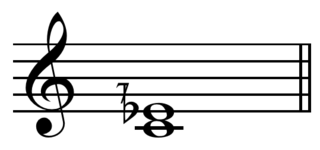
An equal temperament is a musical temperament or tuning system that approximates just intervals by dividing an octave into steps such that the ratio of the frequencies of any adjacent pair of notes is the same. This system yields pitch steps perceived as equal in size, due to the logarithmic changes in pitch frequency.

A quarter tone is a pitch halfway between the usual notes of a chromatic scale or an interval about half as wide as a semitone, which itself is half a whole tone. Quarter tones divide the octave by 50 cents each, and have 24 different pitches.
The Turkish makam is a system of melody types used in Turkish classical music and Turkish folk music. It provides a complex set of rules for composing and performance. Each makam specifies a unique intervalic structure and melodic development (seyir). Whether a fixed composition or a spontaneous composition, all attempt to follow the melody type. The rhythmic counterpart of makam in Turkish music is usul.
In Western music, the adjectives major and minor may describe an interval, chord, scale, or key. A composition, movement, section, or phrase may also be referred to by its key, including whether that key is major or minor.

In music, 53 equal temperament, called 53 TET, 53 EDO, or 53 ET, is the tempered scale derived by dividing the octave into 53 equal steps. Each step represents a frequency ratio of 21⁄53, or 22.6415 cents, an interval sometimes called the Holdrian comma.

In music, 19 equal temperament, called 19 TET, 19 EDO, 19-ED2 or 19 ET, is the tempered scale derived by dividing the octave into 19 equal steps. Each step represents a frequency ratio of 19√2, or 63.16 cents.

In music, the septimal minor third, also called the subminor third or septimal subminor third, is the musical interval exactly or approximately equal to a 7/6 ratio of frequencies. In terms of cents, it is 267 cents, a quartertone of size 36/35 flatter than a just minor third of 6/5. In 24-tone equal temperament five quarter tones approximate the septimal minor third at 250 cents. A septimal minor third is almost exactly two-ninths of an octave, and thus all divisions of the octave into multiples of nine have an almost perfect match to this interval. The septimal major sixth, 12/7, is the inverse of this interval.

A neutral third is a musical interval wider than a minor third but narrower than a major third, named by Jan Pieter Land in 1880. Land makes reference to the neutral third attributed to Zalzal, described by Al-Farabi as corresponding to a ratio of 27:22 and by Avicenna as 39:32. The Zalzalian third may have been a mobile interval.

Rast Panjgah is the name of a dastgah in Iranian music and of a maqam in Arabic and related systems of music.

A septimal quarter tone is an interval with the ratio of 36:35, which is the difference between the septimal minor third and the Just minor third, or about 48.77 cents wide. The name derives from the interval being the 7-limit approximation of a quarter tone. The septimal quarter tone can be viewed either as a musical interval in its own right, or as a comma; if it is tempered out in a given tuning system, the distinction between the two different types of minor thirds is lost. The septimal quarter tone may be derived from the harmonic series as the interval between the thirty-fifth and thirty-sixth harmonics.
In music, 96 equal temperament, called 96-TET, 96-EDO, or 96-ET, is the tempered scale derived by dividing the octave into 96 equal steps. Each step represents a frequency ratio of , or 12.5 cents. Since 96 factors into 1, 2, 3, 4, 6, 8, 12, 16, 24, 32, 48, and 96, it contains all of those temperaments. Most humans can only hear differences of 6 cents on notes that are played sequentially, and this amount varies according to the pitch, so the use of larger divisions of octave can be considered unnecessary. Smaller differences in pitch may be considered vibrato or stylistic devices.
Yeden, in Turkish makam theory, is the note preceding the tonic note (Durak) as the leading tone within a makam.
Rast is the implementation of the Rast scale in Turkish makam music. It is in 53 Tone Equal Temperament.
The Rast pitch class set is a set of scales that are named after the Rast makam. For Rast, there is the Rast tetrachord and Rast pentachord.
Çârgâh is the implementation of the Chahargah scale in Turkish makam music. It is in 53 Tone Equal Temperament. The makam is the central scale used within analysis in the Arel Ezgi Uzdilek system, this is not because this is a scale that's used a lot or otherwise central, but because it can be written without any accidentals.
Basit Suzinak is a makam in Turkish makam music. It is in 53 Tone Equal Temperament.
In Turkish classical music, the Nikriz pitch class set is a set of scales that are named after the Nikriz makam. For Nikriz, there is only the pentachord, as the 4th is raised. The Nikriz pentachord is the same as putting the 53-TET equivalent of a whole step in the beginning of the Hicaz tetrachord.
Nikriz is the a scale in Turkish makam music. It is in 53 Tone Equal Temperament.
In Turkish music, the hicaz pitch class set is a set of scales that are named after the Hicaz Turkish makam. For Hicaz, there is the Hicaz tetrachord and Hicaz pentachord.
Geçki is the usage of a different makam during the performance of another makam, which may or may not lead to a modulation. It is a form of modal interchange, used specifically within Turkish makam music.






